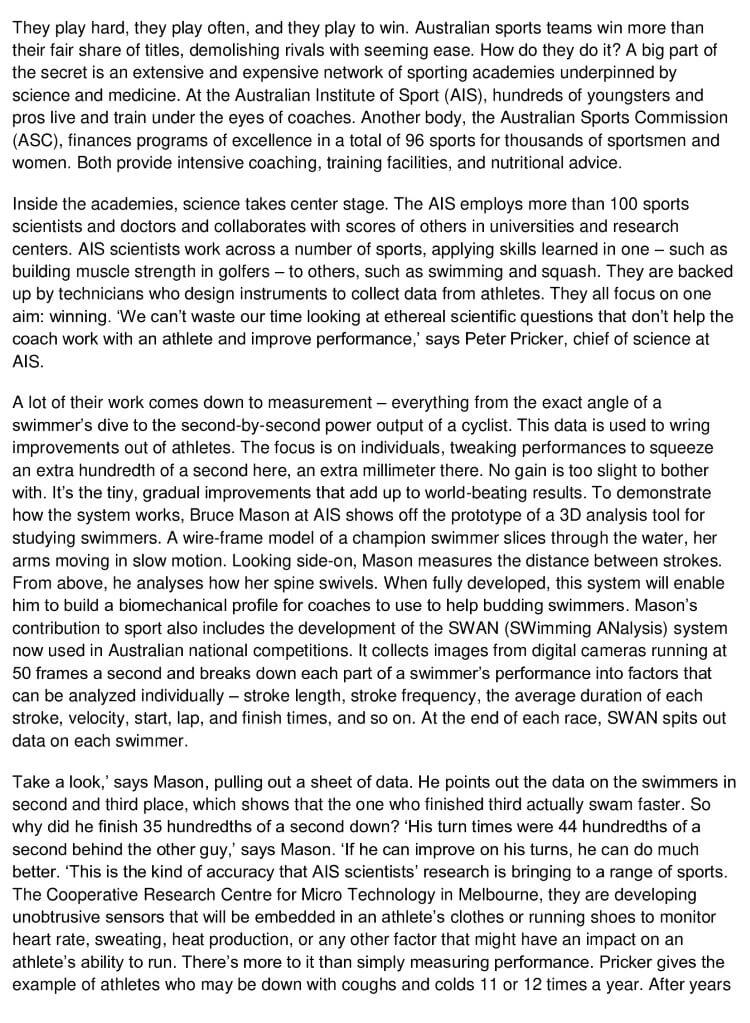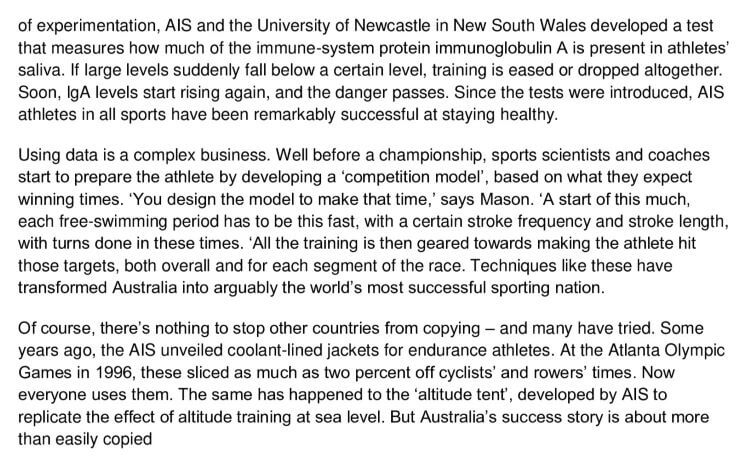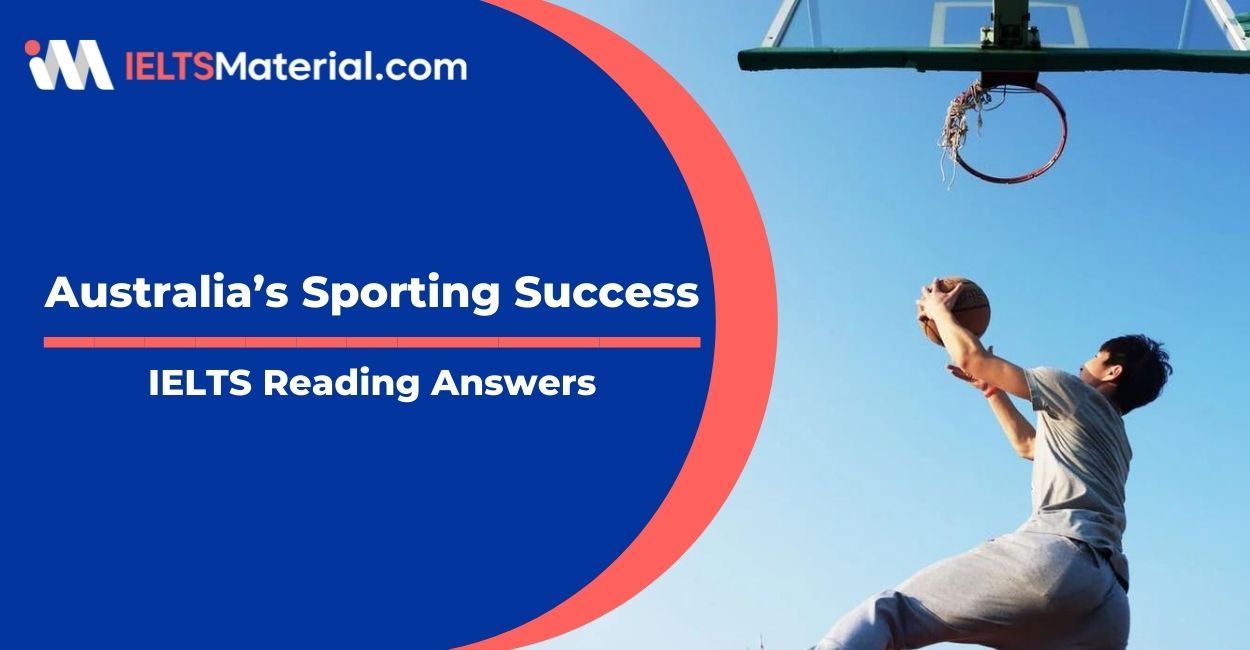Australia’s Sporting Success- IELTS Reading Answer
8 min read
Updated On
-
Copy link
Table of Contents

Limited-Time Offer : Access a FREE 10-Day IELTS Study Plan!
Reading Passage
Australia’s Sporting Success


Questions 1-7
Reading Passage I has six paragraphs, A- F.
Which paragraph contains the following information?
Write the correct letter. A-F. in boxes 1- 7 on your answer sheet.
NB You may use any letter more than once.
1 a reference to the exchange of expertise between different sports
2 an explanation of how visual imaging is employed in investigations
3 a reason for narrowing the scope of research activity
4 how some AIS ideas have been reproduced
5 how obstacles to optimum achievement can be investigated
6 an overview of the funded support of athletes
7 how performance requirements are calculated before an event
Questions 8-11
Classify the following techniques according to whether the writer states they
A is currently exclusively used by Australians
B will be used in the future by Australians
C is currently used by both Australians and their rivals
Write the correct letter. A. B or C, in boxes 8-11 on your answer sheet.
8 cameras
9 sensors
10 protein tests
11 altitude tents
Questions 12 And 13
Answer the questions below.
Choose NO MORE THAN THREE WORDS AND/OR A NUMBER from the passage for each answer.
Write your answers in boxes 12 and 13 on your answer sheet.
12 What is produced to help an athlete plan their performance in an event?
13 By how much did some cyclists’ performance improve at the 1996 Olympic Games?
Reading Answer
1 Answer: B
Question type: Matching Information
Answer location: Paragraph B
Answer explanation: Paragraph B illustrates that the AIS employs more than 100 sports scientists and doctors and collaborates with scores of others in universities and research centers. AIS scientists work across a number of sports, applying skills learned in one – such as building muscle strength in golfers – to others, such as swimming and squash. These lines indicate that Australian sports scientists and doctors share their expertise across different sports. Hence, the paragraph illustrates the sharing of skills between various sports. Thus, the answer is B.
2 Answer: C
Question type: Matching Information
Answer location: Paragraph C, line 5
Answer explanation: In the 5th line of paragraph C, it is stated that to demonstrate how the system works, Bruce Mason at AIS shows off the prototype of a 3D analysis tool for studying swimmers. A wire-frame model of a champion swimmer slices through the water, her arms moving in slow motion. These lines suggest that according to paragraph B, Bruce Mason at AIS shows off a prototype of a 3D analysis tool for swimmers to explain how the system works. A slow-motion wireframe model of a world-class swimmer slashes through the water. Hence, paragraph B illustrates a description of how visual imaging is used in research. Thus, the answer is C.
3 Answer: B
Question type: Matching Information
Answer location: Paragraph B, last line
Answer explanation: The last line of paragraph B states, ‘We can’t waste our time looking at ethereal scientific questions that don’t help the coach work with an athlete and improve performance,’ says Peter Pricker, chief of science at AIS. We can deduce from these lines that according to AIS’s chief scientist, Peter Pricker, athletes must work with their coaches for better performance, not their time can be wasted on ethereal scientific questions. Thus, these lines indicate a rationale for condensing the scope of research. So, the answer is B.
4 Answer: F
Question type: Matching Information
Answer location: Paragraph F
Answer explanation: The initial lines of paragraph F states that Of course, there’s nothing to stop other countries from copying – and many have tried. Some years ago, the AIS unveiled coolant-lined jackets for endurance athletes. At the Atlanta Olympic Games in 1996, these sliced as much as two percent off cyclists’ and rowers’ times. Now everyone uses them. The same has happened to the ‘altitude tent’, developed by AIS to replicate the effect of altitude training at sea level. These lines indicate that techniques have made Australia, the world’s most successful sporting nation. Many countries have attempted their best and nothing can be done to stop them. Thus, paragraph F explains the way certain AIS concepts have been replicated. So, the answer is F.
5 Answer: D
Question type: Matching Information
Answer location: Paragraph D
Answer explanation: Paragraph D states that he points out the data on the swimmers in second and third place, which shows that the one who finished third actually swam faster. So why did he finish 35 hundredths of a second down? ‘His turn times were 44 hundredths of a second behind the other guy,’ says Mason. ‘If he can improve on his turns, he can do much better. ‘This is the kind of accuracy that AIS scientists’ research is bringing to a range of sports. The Cooperative Research Centre for Micro Technology in Melbourne, they are developing unobtrusive sensors that will be embedded in an athlete’s clothes or running shoes to monitor heart rate, sweating, heat production, or any other factor that might have an impact on an athlete’s ability to run. These lines suggest that according to passage D, as a part of their research at the center, they’re working to create sensors that can be worn by athletes or placed in their running shoes to track their heart rates, perspiration levels body heat generation, amongst other things. Thus, para D illustrates how to investigate barriers to optimal performance, so, the answer is D.
6 Answer: A
Question type: Matching Information
Answer location: Paragraph A, 2nd last line
Answer explanation: The 2nd last line of paragraph A states that Another body, the Australian Sports Commission (ASC), finances programs of excellence in a total of 96 sports for thousands of sportsmen and women. Both provide intensive coaching, training facilities, and nutritional advice. According to these lines, there are thousands of sportsmen at the AIS under the watchful eyes of the coaches. Several athletes can take advantage of the funds provided by the AIS. Another government agency, offers high-quality training, coaching, and dietary guidance. Hence, paragraph A explains a summary of the financial support provided to athletics. Thus, the answer is A.
7 Answer: E
Question type: Matching Information
Answer location: Paragraph E
Answer explanation: The introductory lines of paragraph E states that using data is a complex business. Well before a championship, sports scientists and coaches start to prepare the athlete by developing a ‘competition model’, based on what they expect winning times. These lines suggest that according to the passage, data analysis is a delicate manner in the months leading up to a championship, sports scientists and coaches begin preparing the athletes by constructing a competition model based on the predicted winning times for the event. Hence, paragraph E describes how the performance needs are evaluated in advance of the event. Thus, the answer is E.
8 Answer: A
Question type: Multiple Choice Question
Answer location: Paragraph C, last line
Answer explanation: The last line of paragraph C states, that Mason’s contribution to sport also includes the development of the SWAN (SWimming ANalysis) system now used in Australian national competitions. It collects images from digital cameras running at 50 frames a second and breaks down each part of a swimmer’s performance into factors that can be analyzed individually – stroke length, stroke frequency, the average duration of each stroke, velocity, start, lap, and finish times, and so on. According to these lines, the Australians gather photos from 50 frames per second digital cameras and break down every aspect of a swimmer’s performance into distinct components. Hence, the answer is A.
9 Answer: B
Question type: Multiple Choice Question
Answer location: Paragraph D, line 6
Answer explanation: Paragraph D, line 6 states, “With the Cooperative Research Centre for Micro Technology in Melbourne, they are developing unobtrusive sensors that will be embedded in an athlete’s clothes or running shoes to monitor heart rate, sweating, heat production or any other factor that might have an impact on an athlete’s ability to run.” These lines suggest that the Australian scientists are developing sensors that can be hidden inside a runner’s shoes or running gear to monitor everything from heart rate to seat production to body temperature. Hence, the answer is B.
10 Answer: A
Question type: Multiple Choice Question
Answer location: Paragraph D, line 9
Answer explanation: The 9th line of paragraph D illustrates that after years of experimentation, AIS and the University of Newcastle in New South Wales developed a test that measures how much of the immune-system protein immunoglobulin A is present in athletes’ saliva. We can deduce from these lines that after years of experimentation, AIS and the University of Newcastle in New South Wales have developed a saliva test analyzing the amount of the immune-system protein immunoglobulin A in an athlete’s saliva. In this event, when the IgA reduces, training is either relaxed or discontinued. Thus, the answer is A.
11 Answer: C
Question type: Multiple Choice Question
Answer location: Paragraph F, line 2
Answer explanation: The 2nd line of paragraph F states that some years ago, the AIS unveiled coolant-lined jackets for endurance athletes. At the Atlanta Olympic Games in 1996, these sliced as much as two percent off cyclists’ and rowers’ times. Now everyone uses them. The same has happened to the ‘altitude tent’, developed by AIS to replicate the effect of altitude training at sea level. We can understand from these lines that the altitude tent built by the AIS to mimic the effects of altitude training at sea level has fallen victim to the same fate. However, the success of Australia goes well beyond simple technology improvements, and no other country has been able to duplicate its comprehensive system. Hence, the answer is C.
12 Answer: competition model
Question type: Short Answer Question
Answer location: Paragraph E
Answer explanation: The introductory lines of paragraph E states that using data is a complex business. Well before a championship, sports scientists and coaches start to prepare the athlete by developing a ‘competition model’, based on what they expect winning times. It is evident from these lines that in the months leading up to the competition, sports scientists and coaches start preparing the athletes by formulating a competition model based on the predicted winning times for the event. Hence, the answer is the competition model.
13 Answer: (by) 2%
Question type: Short Answer Question
Answer location: Paragraph F, line 2
Answer explanation: The 2nd line of paragraph F states that at the Atlanta Olympic Games in 1996, these sliced as much as two percent off cyclists’ and rowers’ times. Now everyone uses them. These lines indicate that the performance of certain cyclists increased by 2% during the 1996 Olympic games. Hence, the answer is (by) 2%.
Check More IELTS Reading Answers
Practice IELTS Reading based on question types

Start Preparing for IELTS: Get Your 10-Day Study Plan Today!
Recent Articles

Nehasri Ravishenbagam

Haniya Yashfeen

Haniya Yashfeen

Haniya Yashfeen




Post your Comments